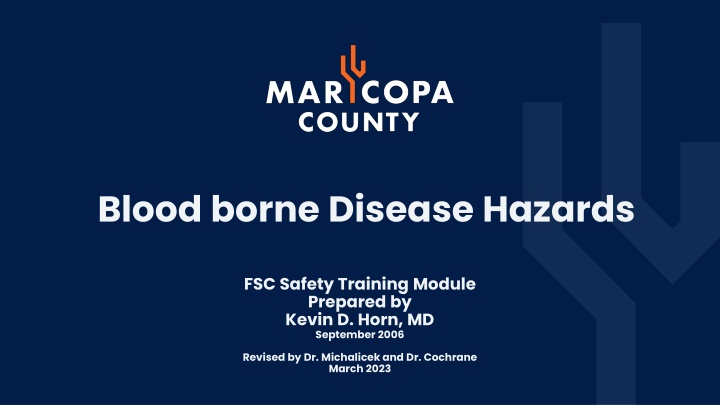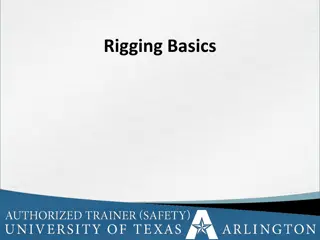Blood-Borne Disease Hazards in Healthcare Settings
Healthcare workers face risks of exposure to bloodborne pathogens like HIV, HBV, and HCV. This training module covers sources and routes of exposure, emphasizing the importance of universal precautions. Specific focus is given to Hepatitis B and C viruses, their impact on the liver, transmission methods, and preventative measures for healthcare professionals.
Uploaded on Aug 26, 2024 | 1 Views
Download Presentation

Please find below an Image/Link to download the presentation.
The content on the website is provided AS IS for your information and personal use only. It may not be sold, licensed, or shared on other websites without obtaining consent from the author.If you encounter any issues during the download, it is possible that the publisher has removed the file from their server.
You are allowed to download the files provided on this website for personal or commercial use, subject to the condition that they are used lawfully. All files are the property of their respective owners.
The content on the website is provided AS IS for your information and personal use only. It may not be sold, licensed, or shared on other websites without obtaining consent from the author.
E N D
Presentation Transcript
Blood borne Disease Hazards FSC Safety Training Module Prepared by Kevin D. Horn, MD September 2006 Revised by Dr. Michalicek and Dr. Cochrane March 2023
Introduction OSHA estimates that 5.6 million workers in the health care industry and related occupations are at risk of occupational exposure to bloodborne pathogens, including human immunodeficiency virus (HIV), hepatitis B virus (HBV), hepatitis C virus (HCV), and others.
Sources of Exposure OSHA defines blood to mean human blood, human blood components, and products made from human blood. Other Potentially Infectious Materials (OPIM) means (1) The following human body fluids: semen, vaginal secretions, cerebrospinal fluid, synovial fluid, pleural fluid, pericardial fluid, peritoneal fluid, amniotic fluid, saliva in dental procedures, any body fluid that is visibly contaminated with blood, and all body fluids in situations where it is difficult or impossible to differentiate between body fluids; (2) Any unfixed tissue or organ (other than intact skin) from a human (living or dead)
Routes of Exposure Needlestick or sharps injuries from contaminated source (having been in contact with decedent blood or fluids, even without visible blood on the instrument at the time of the injury) Splash exposures to mucous membranes (eyes, nose, mouth) or non-intact skin (open wounds) Intact skin exposures to blood and fluids are generally NOT a reason for concern
Organisms Exposure from person known to be infected with: Hepatitis viruses (B and C) HIV/AIDS Much more often, the decedent s disease status is not known Must follow UNIVERSAL PRECAUTIONS on all cases (assume the person is infected)
HEPATITIS VIRUSES (B AND C)
Hepatitis B Virus that attacks the liver Hepatitis B virus (HBV) can cause lifelong infection, cirrhosis (scarring) of the liver, liver cancer, liver failure, and death. In 2003, an estimated 73,000 people were infected with HBV. People of all ages get hepatitis B and about 5,000 die per year of sickness caused by HBV. HBV is spread when blood from an infected person enters the body of a person who is not infected. Healthcare personnel who have received hepatitis B vaccine and developed immunity to the virus are at virtually no risk for infection. For a susceptible person, the risk from a single needlestick or cut exposure to HBV-infected blood ranges from 6-30%. The annual number of occupational infections has decreased 95% since hepatitis B vaccine became available in 1982, from >10,000 in 1983 to <400 in 2001. All healthcare workers should receive HBV vaccine if possible.
Hepatitis C Liver disease caused by the hepatitis C virus (HCV) which is found in the blood of persons who have this disease. The average risk for infection after a needlestick or cut exposure to HCV infected blood is approximately 1.8%. Studies have shown that 1% of hospital healthcare personnel have evidence of HCV infection (about 3% of the U.S. population has evidence of infection). No vaccine is currently available. Treatment involves monitoring of liver function for life and drugs such as interferon which help control viral growth and spread. Complications can include cirrhosis (scarring of the liver) and liver failure, necessitating possible liver transplant
HIV/AIDS (1) Virus infects and disables immune system (T Cells) Exposures occur through needlesticks or cuts from other sharp instruments contaminated with an infected patient's blood or through contact of the eye, nose, mouth, or skin with a patient's blood. Important factors that influence the overall risk for occupational exposures to bloodborne pathogens include the number of infected individuals in the patient population and the type and number of blood contacts.
HIV/AIDS (2) Most exposures do NOT result in infection. Infection MAY result in AIDS, but new protease inhibitor drugs may delay development of full AIDS in HIV-positive persons for many years Vaccine in development, none currently available.
Personal Protective Equipment (PPE) Follow OME Safety Manual guidelines Use ALL of the PPE s EVERY time Proper mask and eye protection to avoid eye, nose, and mouth splashes Sleeves and/or gowns to protect skin surfaces Gloves (double or with Kevlar inserts) to protect hands from cuts, needle injuries.
Sharps Etiquette (1) ALWAYS know where your sharps are in relation to you and your co-workers ALWAYS dispose of sharps in the proper receptacles (this includes sharps taken from the body, including medical instruments, wires, etc). Use care when your hands are in a body region that you cannot see directly (avoid sharp bone fragments, foreign bodies, fragments of projectiles, glass, etc).
Sharps Etiquette (2) NEVER have your hands in an area you cannot see clearly, while someone else is dissecting with a sharp instrument. NEVER recap a needle or remove the needle from the syringe with your hand NEVER remove a scalpel blade with your hand
What To Do When Injured or Splashed Stay calm Assess the injury or areas of your body that were exposed DO NOT wash a cut with bleach or other caustic chemical- this causes more tissue injury and actually promotes virus access to your bloodstream WATER and SOAP are best for cleaning a wound LIGHT pressure to allow wound to bleed freely is recommended to remove some of the contaminating material Use eye wash station or shower if contamination is extensive
Post-Exposure Procedure(1) Notify your supervisor to ensure he/she completes a blood-body fluid exposure report with any exposure (needlestick, splash, etc) through the Risk Management claim system. Testing of your blood should be done without delay for the commonly transmitted organisms (HIV, hepatitis) Following baseline testing, follow-up testing of your blood will be done later (in a few weeks) Postmortem testing of the decedent s blood has a high rate of false- negative results, due to hemolysis (breakdown) of the specimen this is currently not done by the OME
Post-Exposure Procedure(2) If antemortem blood for the decedent is available, testing may be done on this sample; however, you should proceed with testing of your blood and taking the medication to prevent infection regardless Failure to document your exposure with your supervisor may void any coverage for illness in the future which resulted from the exposure Prophylaxis meds should be taken if appropriate, to lessen risk of infection (follow your treating doctor s or employee health provider s advice)
Conclusions We must assume that all cases are infected or contaminated (UNIVERSAL PRECAUTIONS) Consistent use of PPE and sharps etiquette, along with care and attention to your work will prevent most exposures When exposed, follow the procedure and stay calm Even with exposure, risk of infection is usually low
QUESTIONS 1) When exposed, you should NOT: A) Leave work and report to employee health provider B) Wash the injury with concentrated bleach C) Allow testing of your blood for a baseline and then a follow-up serology for antibodies to HIV and hepatitis D) Take the prophylaxis medications, if directed by your physician or employee health provider
2) Risk of transmission of Hepatitis C following an exposure is approximately: a) 95% b) 37.9 % c) 1.8 % d) 74%
3) HIV/AIDS virus acts by: a) Attacking the immune system b) Causing liver damage and cirrhosis c) Interfering with normal functions of the brain d) Causing scarring and inflammation of the lungs
4) Proper sharps etiquette includes all EXCEPT: a) Pointing your scalpel away from your colleague while removing it with your fingers b) Knowing where your hands are at all times when cutting c) Using the sharps container for metal and glass object disposal d) Never recapping a needle after use
5) PPE use should routinely include all EXCEPT: a) An N95 respirator b) Eye protection (shield or safety glasses) c) A gown or apron d) A respirator unit with oxygen
6) This organism has an associated vaccine available: a) Hepatitis B b) HIV/AIDS c) Hepatitis C d) Hantavirus e) Common cold virus
Answers 1) B 2) C 3) A 4) A 5) D 6) A























